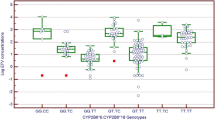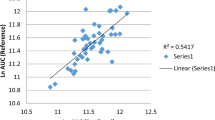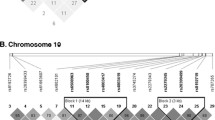Abstract
Objective
The study sought to investigate the relationship between efavirenz exposure and the CYP2B6 516G→T(*6) genotype in HIV/AIDS outpatients, using pharmacokinetic modelling and simulation.
Methods
Blood samples where obtained from 74 outpatients treated with a combination regimen including 600 mg efavirenz daily for a duration of at least 3 weeks at clinics in Harare, Zimbabwe. The subjects were genotyped for the major CYP2B6 variant, CYP2B6*6, associated with reduced enzyme activity, using a PCR-RFLP method. Efavirenz plasma concentrations were determined by HPLC-UV. Population pharmacokinetic modelling and simulation of the data were performed in NONMEM VI.
Results
A high allele frequency of the CYP2B6*6 allele of 49% was observed. Efavirenz plasma concentrations were above 4 mg/L in 50% of the patients. Genotype and sex were identified as predictive covariates of efavirenz disposition. Pharmacokinetic parameter estimates indicate that a dose reduction to 400 mg efavirenz per day is possible in patients homozygous for the CYP2B6*6 genotype without compromising therapeutic efficacy.
Conclusion
The CYP2B6*6 allele occurs at a high frequency in people of African origin and is associated with high efavirenz concentrations. Simulations indicate that an a priori 35% dose reduction in homozygous CYP2B6*6 patients would maintain drug exposure within the therapeutic range in this group of patients. Our preliminary results suggest the conduct of a prospective clinical dose optimization study to evaluate the utility of genotype-driven dose adjustment in this population.



Similar content being viewed by others
References
WHO (2003) Scaling up antiretroviral therapy in resource-limited settings: treatment guidelines for a public health approach, 2003 revision. http://www.who.int/pub/prev_care/en/arvrevision2003en.pdf. Cited April 25, 2007
De Clercq E (2007) Anti-HIV drugs. Verh K Acad Geneeskd Belg 69:81–104
Hahn JA, Maier M, Byakika-Tusiime J, Oyugi JH, Bangsberg DR (2007) Hepatotoxicity during nevirapine-based fixed-dose combination antiretroviral therapy in Kampala, Uganda. J Int Assoc Physicians AIDS Care (Chic Ill) 6(2):83–86
Jamisse L, Balkus J, Hitti J, Gloyd S, Manuel R, Osman N, Djedje M, Farquhar C (2007) Antiretroviral-associated toxicity among HIV-1-seropositive pregnant women in Mozambique receiving nevirapine-based regimens. J Acquir Immune Defic Syndr 44(4):371–376
Rivero A, Mira JA, Pineda JA (2007) Liver toxicity induced by non-nucleoside reverse transcriptase inhibitors. J Antimicrob Chemother 59(3):342–346
Harries AD (2006) HIV/AIDS and TB. Trop Doct 36(2):65–67
Maher D, Harries A, Getahun H (2005) Tuberculosis and HIV interaction in sub-Saharan Africa: impact on patients and programmes; implications for policies. Trop Med Int Health 10(8):734–742
Smith PF, DiCenzo R, Morse GD (2001) Clinical pharmacokinetics of non-nucleoside reverse transcriptase inhibitors. Clin Pharmacokinet 40:893–905
Adkins JC, Noble S (1998) Efavirenz. Drugs 56(6):1055–1064
Barrett J, Joshi AS, Chai M, Ludden TM, Fiske WD, Pieniaszek HJ (2002) Population pharmacokinetic meta-analysis with efavirenz. Int J Clin Pharmacol Ther 40:507–519
Ward BA, Gorski JC, Jones DR, Hall SD, Flockhart DA, Desta Z (2003) The cytochrome P450 2B6 (CYP2B6) is the main catalyst of efavirenz primary and secondary metabolism: implication for HIV/AIDS therapy and utility of efavirenz as a substrate marker of CYP2B6 catalytic activity. J Pharmacol Exp Ther 306:287–300
Haas DW, Smeaton LM, Shafer RW, Robbins GK, Morse GD, Labbe L, Wilkinson GR, Clifford DB, D’Aquila RT, De Gruttola V, Pollard RB, Merigan TC, Hirsch MS, George AL Jr, Donahue JP, Kim RB (2005) Pharmacogenetics of long-term responses to antiretroviral regimens containing efavirenz and/or nelfinavir: an adult AIDS clinical trials group study. J Infect Dis 192:1931–1942
Ribaudo H, Haas DW, Tierney C, Kim RB, Wilkinson GR, Gulick RM, Clifford DB, Marzolini C, Fletcher CV, Tashima KT, Kuritzkes DR, Acosta EP (2006) Pharmacogenetics of plasma efavirenz exposure after treatment discontinuation: an adult aids clinical trials group study. Clin Infect Dis 42:401–407
Rotger M, Colombo S, Furrer H, Bleiber G, Buclin T, Lee BL, Keiser O, Biollaz J, Décosterd L, Telenti A and the Swiss HIV cohort study (2005) Influence of CYP2B6 polymorphism on plasma and intracellular concentrations and toxicity of efavirenz and nevirapine in HIV-infected patients. Pharmacogenet Genomics 15(1):1–5
Staszewski S, Morales-Ramirez J, Tashima KT, Rachlis A, Skiest D, Stanford J, Stryker R, Johnson P, Labriola DF, Farina D, Manion DJ, Ruiz NM (1999) Efavirenz plus zidovudine and lamivudine, efavirenz plus indinavir, and indinavir plus zidovudine and lamivudine in the treatment of HIV-1 infection in adults. Study 006 Team. N Engl J Med 341:1865–1873
Robbins GK, De Gruttola V, Shafer RW, Smeaton LM, Snyder SW, Pettinelli C, Dube MP, Fischl MA, Pollard RB, Delapenha R, Gedeon L, van der Horst C, Murphy RL, Becker MI, D’Aquila RT, Vella S, Merigan TC, Hirsch MS; AIDS Clinical Trials Group 384 Team (2003) Comparison of sequential three-drug regimens as initial therapy for HIV-1 infection. N Engl J Med 349:2293–2303
Bartlett JA, Johnson J, Herrera G, Sosa N, Rodriguez A, Liao Q, Griffith S, Irlbeck D, Shaefer MS (2006) Long-term results of initial therapy with abacavir and lamivudine combined with efavirenz, amprenavir/ritonavir, or stavudine. J Acquir Immune Defic Syndr 43:284–292
Daneil C, Moh R, Anzian A, Abo Y, Chenal H, Guehi C, Gabillard D, Sorho S, Rouet F, Eholie S, Anglaret X (2006) Tolerance and acceptability of an efavirenz-based regimen in 740 adults (predominantly women) in west Africa. J Acquir Immune Defic Syndr 42(1):29–35
Wester CW, Kim S, Bussman H, Ndwapi N, Peter TF, Gaolathe T, Mujugira A, Busang L, Vanderwarker C, Cardiello P, Johnson O, Thior I, Mazonde P, Moffat H, Essex M, Marlink R (2005) Initial response to highly active antiretroviral therapy in HIV-1C infected adults in a public sector treatment program in Botswana. J Acquir Immune Defic Syndr 40:336–343
Kebba A, Atwine D, Mwebaze R, Kityo C, Nakityo R, Peter M (2002) Therapeutic responses to AZT + 3TC + EFV in advanced antiretroviral naive HIV type 1-infected Ugandan patients. IDS Res Hum Retroviruses 18:1181–1187
Coetzee D, Hildebrand K, Boulle A, Maartens G, Louis F, Labatala V, Reuter H, Ntwana N, Goemaere E (2004) Outcomes after two years of providing antiretroviral treatment in Khayelitsha, South Africa. AIDS 18:887–895
Marzolini C, Telenti A, Decosterd LA, Greub G, Biollaz J, Buclin T (2001) Efavirenz plasma levels can predict treatment failure and central nervous system side effects in HIV-1-infected patients. AIDS 5:71–75
Holford N (1999) Target concentration intervention: beyond Y2K. Br J Clin Pharm 48:9–13
Beal SL, Sheiner LB, Boeckmann AJ (eds) (1986–2006) NONMEM users guides. Icon Development Solutions, Ellicot City, MD, USA
Lindbom L, Pihlgren P, Jonsson EN (2005) PsN-toolkit—a collection of computer intensive statistical methods for non-linear mixed effect modeling using NONMEM. Comput Methods Programs Biomed 79(3):241–257
Savic RM, Wilkins JJ, Karlsson MO (2006) (Un)informativeness of empirical Bayes estimate-based diagnostics. AAPS J 8(S2):abstract T3360
Burger D, van der Heiden I, la Porte C, van der Ende M, Groeneveld P, Richter C, Koopmans P, Kroon F, Sprenger H, Lindemans J, Schenk P, van Schaik R (2005) Interpatient variability in the pharmacokinetics of the HIV non-nucleosid reverse transcriptase inhibitor efavirenz: the effect of gender, race and CYP2B6 polymorphism. Br J Clin Pharm 61:148–154
Haas DW, Ribaudo HJ, Kim RB, Tierney C, Wilkinson GR, Gulick RM, Clifford DB, Hulgan T, Marzolini C, Acosta E (2004) Pharmacogenetics of efavirenz and central nervous system side effects: an adult AIDS clinical trials group study. AIDS 18:2391–2400
van Twillert G, van Santen G, Godfried MH (2005) Severe psychosis in an African woman due to the antiretroviral agent efavirenz. Ned Tijdschr Geneeskd 26:2687–2689
Spire B, Carrieri P, Garzot MA, L’Henaff M, Obadia Y, TRT-5 Group (2004) Factors associated with efavirenz discontinuation in a large community-based sample of patients. AIDS Care 16:558–564
Lamba V, Lamba J, Yasuda K, S Strom, J Davila, Hancock ML, Fakenthal JD, Rogan PK, Ring B, Wrighton SA, Schuetz EG (2003) Hepatic CYP2B6 expression: gender and ethnic differences and relationship to CYP2B6 genotype and CAR(constitutive androstane receptor) expression. J Pharmacol Exp Ther 307(3):906–922
Wolbold R, Klein K, Burk O, Nüssler AK, Neuhaus P, Eichelbaum M, Schwab M, Zanger UM (2003) Sex is a major determinant of CYP3A4 expression in human liver. Hepatology 38(4):978–988
Csajka C, Marzolini C, Fattinger K, Decosterd LA, Fellay J, Telenti A, Biollaz J, Buclin T (2002) Population pharmacokinetics and effects of efavirenz in patients with human immunodeficiency virus infection. Clin Pharm Ther 73:20–30
Pfister M, Labbé L, Hammer SM, Mellors J, Bennett KK, Rosenkrantz S, Sheiner LB (2003) Population pharmacokinetics and pharmacodynamics of efavirenz, nelfinavir and indinavir: adult AIDS clinical trial group study 398. Antimicrob Agents Chemother 47:130–137
Kappelhoff BS, Huitema AD, Yalvac Z, Prins JM, Mulder JW, Meenhorst PL, Beijnen JH (2005) Population pharmacokinetics of efavirenz in an unselected cohort of HIV-1-infected individuals. Clin Pharmacokinet 44:849–861
Holford NHG, Kimko HC, Montleone JPR, Peck C (2000) Simulation of clinical trials. Annu Rev Pharmacol Toxicol 40:67–95
Turpeinen M, Raunio H, Olavi P (2006) The functional role of CYP2B6 in human drug metabolism: substrates and inhibitors in vitro, in vivo and in silico. Curr Drug Metab 7:705–714
Acknowledgements
We are grateful to the Wilkins and Beatrice Infectious Disease Clinics for assistance with sample collection. We are grateful to AstraZeneca, Mölndal, DMPK Development Section and Dr. Xueqing Li for hosting Christopher Nyakutira for a 3-month bioanalytical training. Emmanuel Chigutsa is a recipient of a master’s fellowship from the International, Clinical and Operational Health Services Research Training Award (ICOHRTA) for AIDS and TB. Tafadzwa Mhlanga’s assistance with the CYP2B6*6 genotyping work is also acknowledged.
Author information
Authors and Affiliations
Corresponding author
Additional information
Christopher Nyakutira and Daniel Röshammar made equal contributions to this work.
Rights and permissions
About this article
Cite this article
Nyakutira, C., Röshammar, D., Chigutsa, E. et al. High prevalence of the CYP2B6 516G→T(*6) variant and effect on the population pharmacokinetics of efavirenz in HIV/AIDS outpatients in Zimbabwe. Eur J Clin Pharmacol 64, 357–365 (2008). https://doi.org/10.1007/s00228-007-0412-3
Received:
Accepted:
Published:
Issue Date:
DOI: https://doi.org/10.1007/s00228-007-0412-3




